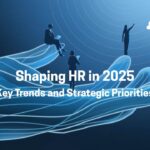The Future of Work: What’s Ahead in 2025
The global labor market is undergoing rapid transformation, driven by technological advancements, geoeconomic fragmentation, economic uncertainty, demographic shifts, and the green transition. These forces are reshaping industries, economies, and workforces worldwide, redefining job opportunities and skill requirements. The “Future of Jobs Report 2025” by the World Economic Forum provides a comprehensive analysis of these changes, drawing insights from over 1,000 leading global employers representing more than 14 million workers across 22 industry clusters and 55 economies. The report highlights the impact of automation, artificial intelligence (AI), and evolving workforce strategies, offering a roadmap for employers and workers navigating the shifting employment landscape from 2025 to 2030.
The Growth of AI and Automation
AI and automation are revolutionizing industries, but their effects vary depending on the sector. At the same time, industries like information technology are leading AI adoption, while sectors such as construction lag behind. The impact of AI is expected to increase significantly, with 86% of businesses expecting AI and information processing technologies to transform their operations by 2030. Despite concerns about job displacement, AI is more likely to enhance human skills rather than fully replace workers. Jobs that require critical thinking, problem-solving, and interpersonal skills remain relatively safe from automation.
The Changing Job Market: What to Expect
- AI and automation will replace some routine and manual jobs but will also create new opportunities in technology, AI management, and human-AI collaboration.
- Jobs such as AI and Machine Learning Specialists, Data Analysts, and Software Developers are expected to see the most growth.
- However, roles such as Data Entry Clerks, Cashiers, and Telemarketers are among the most at risk of disappearing due to automation
Workforce Strategies for the Future
As technology evolves, companies must invest in employee training to bridge skill gaps. According to the report, 85% of companies plan to upskill their workforce, while 73% will accelerate automation. By 2030, key in-demand skills will include AI and Big Data for handling vast information, creative thinking for workplace innovation, and resilience and agility to adapt to dynamic work environments. Employers are adapting to workforce trends by investing in reskilling and upskilling (63%) to keep up with technology, improving talent progression (62%) for career growth, offering higher wages (50%) to retain skilled employees, and expanding remote and hybrid work (47%) as a lasting post-pandemic shift.
The Green Economy and Sustainability Jobs
The transition to a more sustainable economy is also driving job growth. Roles such as Renewable Energy Engineers and Sustainability Specialists are expected to be in high demand as businesses adopt greener practices. The workplace of 2030 will see more collaboration between humans and technology. By 2030, about 34% of tasks will be completed by machines, 34% by humans, and 32% through human-machine collaboration.
What This Means for Workers:
- Employees should focus on developing human-centered skills such as leadership, empathy, and critical thinking.
- Learning to work alongside AI and automation tools will be crucial.
The future of jobs is not just about AI and automation but it’s about adaptation. The workers and companies that focus on continuous learning, technological literacy, and human-centered skills will thrive in the evolving job market. Investing in reskilling, prioritizing employee well-being, and embracing new technologies will define the workforce of tomorrow. For businesses, the key takeaway is clear: those that invest in their workforce today will be the leaders of tomorrow.

